Best Practices for Outsourcing Software Development in 2022

Here you can learn how to outsource software development smartly and promote the best outcomes in the long run.
More and more companies outsource software development needs due to ever-growing consumer expectations, competition, and digital transformation across multiple industries. Non-tech firms, digital startups, and even tech giants can tap into the global IT talent pool, cut costs, and innovate while focusing on core business activities and growth.
This article also addresses the challenges associated with searching for and building relationships with software development outsourcing partners. Entities doing it for the first time often make mistakes that result in project failures and time and money loss.
Let’s overview the five main pitfalls first.
5 Software Development Outsourcing Mistakes to Avoid
1. Unclear goals and requirements
The endeavor is not limited to mere software development project outsourcing: there are several levels of underlying needs. However, business owners often begin searching for agencies and developers without really understanding what needs to be done, why, and how.

Your goal is to find a detail-oriented outsourcing partner that focuses on the proper outcomes instead of output and would cooperate with you to elevate your brand. A diligent provider will first inquire about your present situation, why you seek outsourced software development services, what goals you set, and so forth.
Questions about the budget are reasonable and welcome. If you underestimate the project scope and overestimate your capabilities, you risk running out of money before the product is ready. You also have to set realistic project timelines and success criteria.
With a vague idea of the product and its desired characteristics, it is nearly impossible to estimate its cost, find the optimal ways to implement your ideas, and then understand whether the developers are doing the right thing.
Additional risks may stem from the absence of at least one tech-savvy person on your side, if not a full-time Product Owner, to formulate and share the requirements, monitor the development and product quality, etc.
2. Skipping a proper research
With thousands of IT outsourcing companies on the market, feeling overwhelmed is easy. Entrepreneurs may rush the process by skipping the necessary research and reference checks.
However, behind a pretty online facade, they can encounter small firms assembling ad hoc teams of freelancers or intermediaries further outsourcing projects to countries with the cheapest workforce. This is fraught with poor quality, failed deadlines, and wasted money.
3. Putting cost over expertise and quality
It happens that companies, especially startups with limited resources, choose an IT outsourcing model based solely on the perceived cost-efficiency or select a vendor with the lowest quote.
A short-term agreement to deliver a product fast and cheaply may bring bad outcomes. Working hastily and knowing there will be no cooperation afterward, the contractor may overlook your business goals, omit proper quality assurance, and so forth. Unscrupulous vendors can even conceal costs like taxes, duties, or third-party fees during negotiations.
A reputable IT firm with proven effective processes and expertise is unlikely to charge the lowest fees. Usually, it is inexperienced developers that agree to low salaries.
For this reason, it is wise to aim at ‘middle ground’ prices, negotiate a milestone payment system, and strive to build software along with a lasting outsourcing relationship.
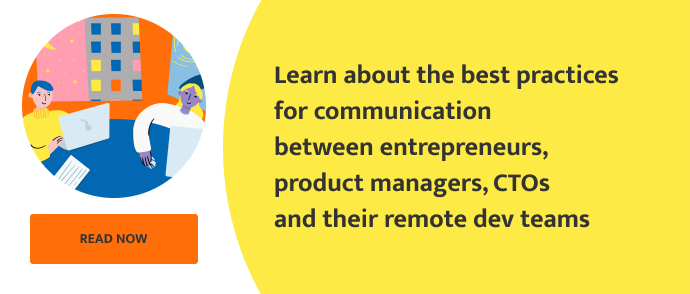
4. Underestimating the communication aspect
Understanding between the parties located in different countries, time zones, and cultural and religious environments may be challenging. The problem may encompass personnel dispersed halfway around the world, insufficient English proficiency, cultural incompatibility, etc. Miscommunication, misinterpretation, and confusion cause delays, costly reworks, and conflicts.
For instance, setting overlapping working hours for a face-to-face discussion of changes in the project may be tricky. The standards regarding punctuality, criticism, management, creativity, politeness, acceptability of certain product functions and content, etc., also vary.
Your company may also lack experience in organizing the technical cooperation between distributed teams that must share the same coding practices and seamlessly exchange knowledge. Your project and task management, communication, and other tools may be alien to remote developers.
Proper communication channels are essential from the first interaction with prospective outsourcing partners. It would also help to prepare for the contractor’s team onboarding.
5. Neglect of the security risks and regulatory compliance
Companies that outsource software development projects often need to share sensitive business information and source code that partners might mishandle.
Data privacy regulations apply to owners of data and third parties that handle it. For example, according to the General Data Protection Regulation (GDPR), even offshore developers are obliged to protect the personal data of EU citizens and residents. Working with non-compliant companies can entail penalties reaching €20 million or 4% of your last year’s revenue.
Your software outsourcing partner must have an established security policy in place and comply with essential international security standards, such as GDPR, PCI DSS, ISO/IEC 27001, and industry-specific regulations.
By choosing the right outsourcing partner, you can avoid costly mistakes, prevent problems, and get the most of your money. Let us share some best practices for outsourcing software development smoothly and safely.
IT Outsourcing: Best Practices for Engaging the Best Partner
You can consider these tips as a step-by-step guide to outsourcing software development projects.
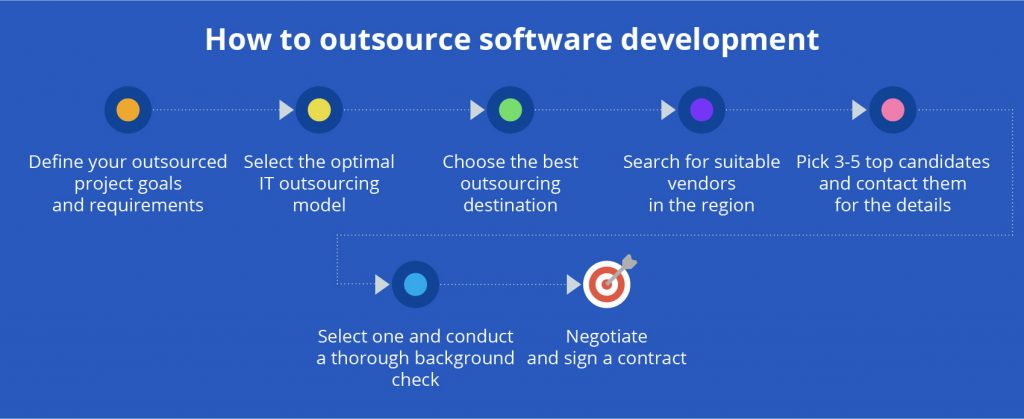
1. Formulate your needs, goals, and requirements as clearly as possible.
Before you start looking for potential outsourcing partners, you need to analyze your situation and expectations to understand
- what problems you face
- your business goals and tasks you want to complete
- what you want to build
- whether you want a minimum viable product (MVP) or a full-fledged scalable software
- who will use the product
- how it will generate revenue
- how much you can afford to invest in it
- what trade-offs you might make and what is unacceptable
- the extent of your involvement in the work done remotely
- whether you plan a short-term or long-term partnership and post-release interactions
For example, you may require help related to
- Product discovery
- Lean inception
- Prototyping
- User experience (UX) and user interface (UI) design
- Brand development
- Web development
- Mobile application development
- AR/VR development
- DevOps consulting
- Quality assurance
- Usability testing and validation
- Project management
- Support and maintenance
- UX/UI audit and data-driven improvements
… or everything at once.
It’s vital to have a clear vision of the product and its development and communicate it within your own company and then to outsourced service providers. Here are several tips:
- List the persons responsible for the IT services selection.
- Write down the business goals behind hiring an external team.
- List your project requirements using a specification or another document. The required documents may include:
- The type of software to build, e.g., a web or mobile app, VR simulator, game, etc.
- Specific tasks or functions it should perform, how, and for what purpose
- Detailed user stories
- Design details and examples of existing applications that you like
- The preferable tech stack, especially if your in-house team should work on the project afterward
- Estimated deadlines for the initial delivery or market launch
4. List the duties and responsibilities of the future vendor and any extra requirements, e.g., proximity to your headquarters so you can visit the vendor if needed.
5. Discuss these documents with the stakeholders and decision-makers.
When outsourcing software product development from scratch or doing it for the first time, it’s reasonable to engage some agency right at this stage. Even if you don’t hire them to build the final product, they still will help with research, preparing requirements documents, and estimating the costs, aiding in search of a long-time partner. Hiring an agency that knows the product from inception will undoubtedly be a bonus.
The next step is to transform your needs and requirements into your search criteria.
2. Choose a suitable software developmentoutsourcing model.
Different IT outsourcing models provide different flexibility regarding the project scope, timeline, or budget planning. You will most likely choose between the following payment structures:
Fixed-price (project-based) contract
The vendor must deliver a product within an established time and budget. The final price is arranged at the start, which requires the knowledge of the exact scope, milestones, deadlines, and goals. It takes some time to clarify and write down these terms before you can start.
The vendor is responsible for your project from A to Z. The price will not change during the development, but the requirements are also fixed. If you need a change, you would have to renegotiate the deal, causing further delays.
This approach is suitable for small projects with clearly defined requirements. If both parties are ready to deal with a limited number of specified change requests or extra negotiations, it should work.
Time-and-material contract, aka hourly rates
You would pay for the specialists’ actual work on your project at an hourly rate fixed for everyone. This approach allows for a quick start and for changing the requirements according to your business needs. The end date is not set.
A T&M contract works well for projects with a short life cycle, small to medium projects with fluid requirements, or when your existing software requires slight modifications. However, the budget becomes harder to predict.
Since hourly rates are higher than the monthly rates of dedicated developers, this is not the best option for a long-term partnership but suitable for filling a skill gap or ramping up your team during the high season.
Dedicated team model
A vendor usually assembles a dedicated team from its available specialists based on a client’s specific project requirements. The team is focused on that project full-time. It is managed either by an assigned project manager (PM) or by the client, who can define the number of developers and their workload and control the processes.
The monthly payments include each specialist’s salary plus the vendor’s fixed service fee.
This cooperation model is flexible and fully adaptable to changes. It is an optimal choice for long-term projects with fluid requirements, software that requires the full attention of a dedicated team 24/7, or when the client’s staff lacks specific expertise for a new complex project.
Your choice will depend on your project needs and how much control you’d exert over the external team’s actions. The next step is to decide where it should be located.
3. Choose the optimal outsourcing destination.
You can find a software development outsourcing partner onshore (domestically), nearshore (in a neighboring country or within 1-3 time zones from your office), or offshore (at a greater distance). If you plan to scale your business, focusing on the local talent pool makes sense. If your goal is cost reduction, it would help to compare the hourly rates of programmers globally.
The biennial Kearney’s Global Services Location Index is arguably the best starting point in research into countries with a developed outsourcing culture. For example, India, China, the Philippines, Brazil, or Poland are usually among the top choices for IT projects outsourcing, but are any of them right for you?
It’s helpful to use the following selection criteria.
- Your optimal time zone
The maximum overlap of the working hours of your company and remote developers ensures convenience, real-time cooperation, and quick feedback and modifications. Nearshoring combines a broader choice of talent with relatively easy communication.
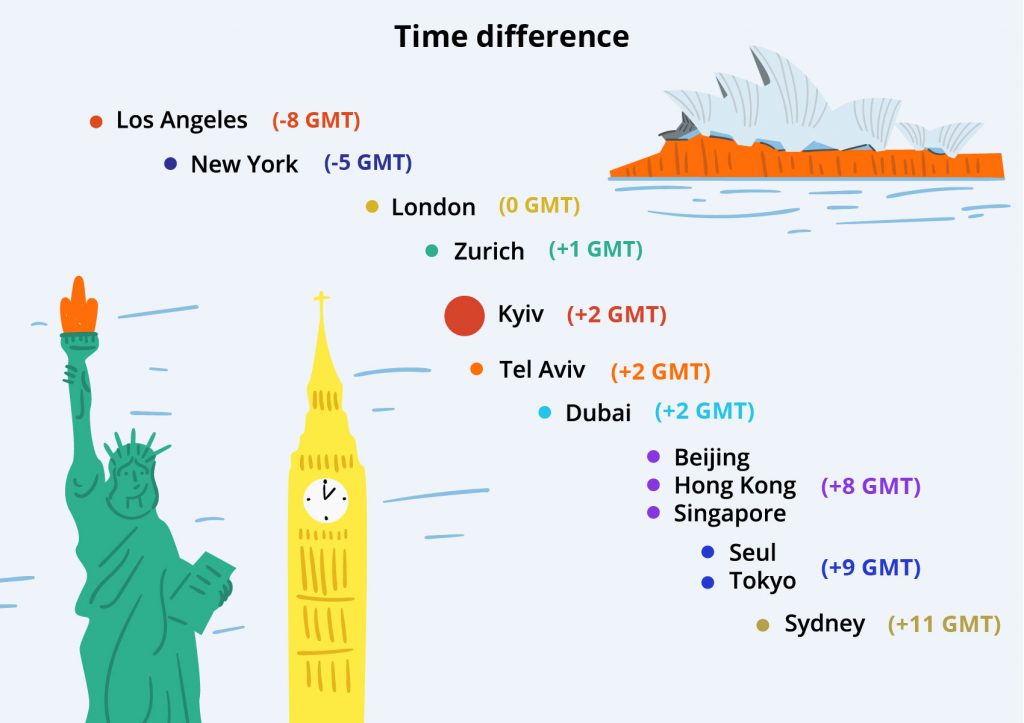
Even a significant time gap is not always a disadvantage. For example, some companies want technical support during hours that complement their hours of operation.
2. Suitable hourly rates
Start with analyzing the average annual salaries/hourly rates of IT specialists in different regions, prioritizing your preferred time zones

Narrow down the search to countries. It’s better to choose among recognized outsourcing destinations with moderate pricing. If a country’s prices are much lower than its neighbors’, it might imply a lower quality of delivered services.
Eastern European countries may be regarded as the ‘middle ground.’ This region has one million IT specialists available at attractive rates. Tech giants and even small family-owned businesses equally successfully outsource software development there.
Popular IT outsourcing destinations, such as Poland, Ukraine, or Romania, are located on the crossroads of major routes from Europe to Asia and from the Scandinavian countries to the Mediterranean. Their capitals are easy to reach from major business hubs. Comfortable time differences, visa-free travel, and short flights facilitate outsourcing partnerships.
3. Cultural fit
Even if you need to complete a small, short-term task, the closer your mentality is to the prospective developers, the better. Common or similar legislation, ethical principles, and language can help nurture smooth collaboration and a lasting trusted partnership.
For instance, IT professionals from Asia and Africa are among the most affordable but can have issues communicating in English. Their colleagues in Eastern Europe have higher English proficiency rates, share the values of the Western culture, and efficiently cooperate with European and American businesspeople and colleagues.
4. Look for outsourcing companies in the chosen country.
You can do it via Google search or on specialized network sites, such as Clutch, GoodFirms, AppFutura, or Upwork. These can quickly give you information about
- a potential partner’s level of expertise
- previous projects
- time on the market
- ratings and awards
- client reviews
- rates
You can also search in Gartner, Forrester, or other industry media’s research papers and market leaders lists, post a job on LinkedIn, or ask friends and colleagues for references.
Select 5-6 agencies that seem to meet your requirements at a glance. Facebook and Google reviews might be helpful, as well as any reputable industry awards.
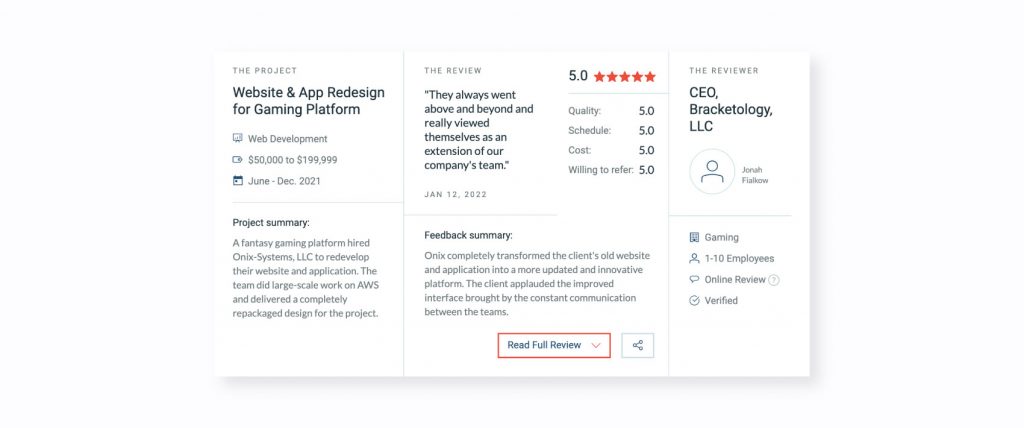
- Upwork named alternative-spaces as their Breakthrough award winner for 2020.
- We are among Ukraine’s top Ruby on Rails development teams listed on Clutch.
- Alternative-spaces’s VR team earned a place in MobileAppDaily’s top VR companies.
The next part involves deeper research into the shortlisted companies. Evaluate each candidate’s portfolio and customer reviews. Examine their websites, LinkedIn and other social media accounts, publications, etc., to learn more. For instance, registration or offices in your country might aid your interactions with an outsourcing partner.
It’s helpful to contact their past clients and inquire about each outsourced software development provider in question. Ask about their experience, satisfaction with the result, and whether they’d work with the provider again. If they say “yes,” the candidate is approved. This will likely leave you with 3-5 potential partners.
5. Contact the candidates, evaluate them, and choose one.
Get in touch with the selected companies. You’ll need to evaluate their technical expertise, skill sets, access to the latest technology, experience in solving complex challenges, and other things that you can learn only during direct communication. Simultaneously, you need to explain what you expect from the partnership.
Require an NDA from each candidate and only then share your project details. This may occur via email, live chat, or on the phone.
Pay attention to how fast everyone responds, their concern for the legal issues, and their willingness to understand and document your needs and project scope, schedule an extra call, or follow up on you. The lack of enthusiasm and genuine interest in you is a red flag.
Ideally, the first meeting should be face-to-face, albeit virtually, especially if your project is long-term. Make sure to organize at least one talk before signing any documents or paying money.

Write down each representative’s answers in a spreadsheet to compare the offers afterward.
The first thing to ask is whether they have hands-on experience in similar projects in your industry and possess the human resources your project demands. Learn how many senior and junior specialized developers they can offer.
Ask about a firm’s current and past clients. Contracts with companies from your country in your industry and completed projects similar in scope to yours are good indicators.
Learn about the firm’s communication channels, the technologies they are using, management styles, how the work proceeds, and how they deliver products to clients.
Ask whether their teams practice Agile methodologies which promote greater flexibility, increased productivity, and cost reduction.
Transparency, open communication, and clear and straightforward language are an advantage. Beware candidates that always answer ‘yes,’ tell you exactly what you want to hear, or promise to do everything that is not feasible for other companies.
Alleged expertise in all industries, technological fields, and programming languages is suspicious. Still, it’s also unreasonable to choose a team with expertise in limited technologies, even if they are the best. You may not be interested in big data, VR, or AI technologies now but may need them eventually. A mature vendor with diverse tech expertise is the best choice.
Ask whether the agency is GDPR-ready, how often they conduct network and security audits in their workplace, and what tools they will use to protect your business’ and consumers’ data and prevent data leaks.
You also need to know how fast they can ramp your team up and down and adjust to your changing needs. A small firm may lack the necessary talent or experience for work on a bigger scale. Larger vendors have ample internal resources and external talent pools, but vendors working primarily with large enterprises may fail to devote enough attention to your specific needs. Choosing a firm similar in size to yours sounds wise.
At this point, you can select 2-3 candidates to send a Request For Quotation (RFQ) to. The document should include at least
- business overview and goals
- product specifications
- business constraints
Ask the candidates to estimate the cost and duration for your project, breaking down the price in a standard formal manner. Remember that you will pay not only for coding; the estimates should include environment setup and application deployment, team meetings, testing and reviews, production monitoring, etc.
Along with insights into each vendor’s knowledge and expertise around the domain, the comparison of several detailed quotations will give you a more accurate idea of your project cost. Don’t rush after the lowest quote, though: those are still approximate numbers, and you may negotiate the best deal possible with the one who best understands your business needs.
6. Run a thorough final background check
To dispel any doubts, you may request extra references from the firm’s current clients and those who outsourced to them projects similar to yours.

As a small testing task, you may ask the designers to create a logo or landing page mockup. To evaluate the code of your potential outsourcing team, you can check out their Git repository.
Clarify the technical questions such as
- What files you can access throughout the project duration
- Whether you can access the source code via GitHub or another repository of your choice
- What industry standards the firm supports
- What coding standards the developers follow
- Whether they use automated static analyzers
- Whether they maintain technical documentation associated with the source code
- Whether the future team can be equipped with all the infrastructure required to develop, test, deliver, and support your digital product
- What happens if you are not satisfied with the services or product quality
Usually, it’s the vendor’s job to vet the staff for your outsourced project or dedicated team, but it would be normal to assess the specialists’ skills and approve them personally if you want. You can give test tasks and interview them. The persons you are going to interact with should have a sufficient level of English proficiency, but other soft skills are also important.
Try to see the company’s office to ensure your future team has comfortable working conditions.
You can also arrange demonstrations of the tech solutions the team proposes and test-drive their existing digital products to get a taste of what to expect.
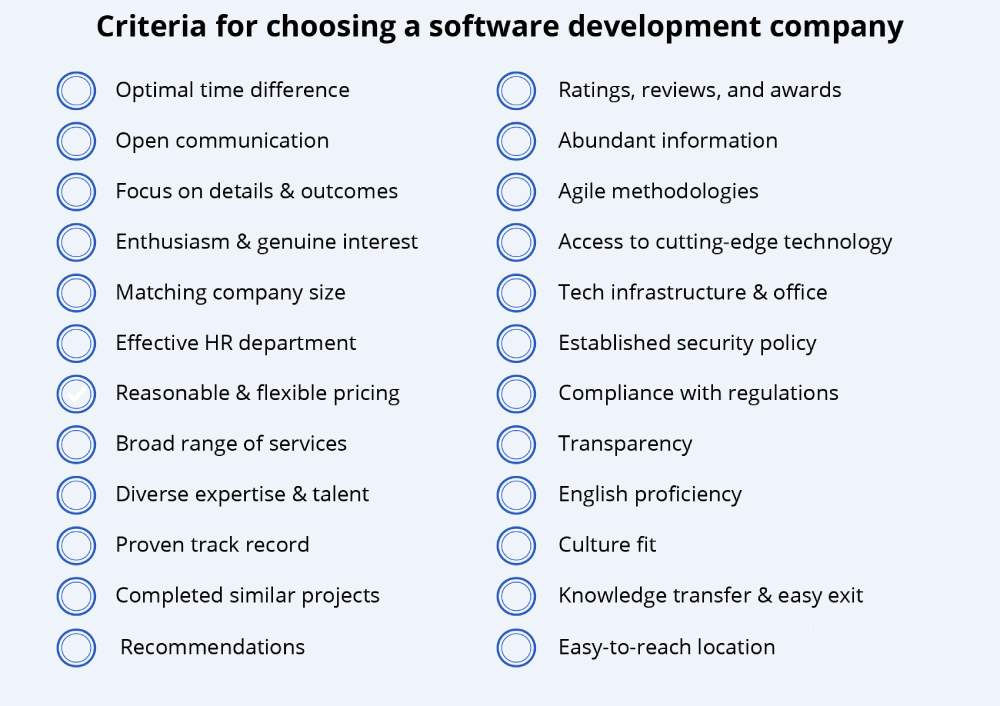
If everything is OK, the parties can close on the deal.
7. Negotiate and sign a detailed contract.
Make sure to get people from your technical, sales, finance, and legal departments to review all contract clauses before finalizing the deal.
For example, you need to agree on a ballpark estimate of the overall cost. Its standard components are:
- the categories of product features
- timeframe for each feature
- team details
- budget
- additional costs
Discuss the optimal outsourcing model and put your agreement on paper or digital document. You need to know precisely how the hourly rate is structured and consider your absolute financial limit: estimates tend to change throughout development.
You also need to reach an understanding regarding:
- A schedule of meetings with the team
- A plan for checking intermediate results
- Time-based and project-based performance metrics
- Product reviews and testing plan, including applicable test types
- Secure means of transferring information on the project
- Access control over sensitive data on both sides
- The use of emails, messengers, phone, video calls, and other communication means
- The use of project management tools, e.g., Jira, Asana, Basecamp, Trello, etc.

The contract formats commonly used in software development outsourcing are:
- NDA (non-disclosure agreement), where two parties agree to protect confidential information disclosed in the course of business and prevent the transformation of original ideas into software by unauthorized parties. IT companies normally sign it at the pre-project stage for the project’s duration.
- SRS (software requirements and specifications).
- SLA (service-level agreement) setting forth the project requirements, prerequisites, nice-to-haves, timeframes, meeting times, reports, events that trigger payment, budget constraints, and even the time and resources allocated for the unforeseen.
- SoW (statement of work), a detailed narrative description of all aspects of your project, including milestones and mini-goals, and supplied software services. It provides the structure for the project plan.
- KPIs (key performance indicators), an instrument for evaluating the project’s phases by matching intermediate results with agreed SRS.
- MSA (master service agreement) that forms the basis for a long-term outsourcing partnership and covers generic terms and conditions for multiple projects within it.
Confidentiality, liability, data protection, regulation compliance, and intellectual property rights need special attention. A contract should explicitly state that you own the rights to the product and will receive the source code. Sometimes, contractors use open-source components and libraries. To prevent your software from becoming open-source, you may forbid that and oblige the developers to use their own components instead.
An exit plan should set transparent and fair procedures for both parties when the cooperation concludes or terminates prematurely. Particularly, the vendor must ensure that project knowledge is well-documented and transferred to you when the partnership ends.
Lawyer review is mandatory before signing a contract. The parties typically abide by different national governing laws and competent courts but can agree on which law system applies to the project in the contract. If your own country’s law isn’t an option, you can meet halfway and agree on a popular law system foreign to both, e.g., British law.
Wrapping Up
If you have difficulty finding local IT talent, their salaries are steep, or your team is too busy to handle new software projects, outsourcing offers a great alternative.
Begin with research on the markets of outsourced software development services and then into selected providers’ portfolio, references, etc. Well-defined project scope and goals and effective communication will help you choose a suitable provider and facilitate your product development.
Sign NDAs with each potential partner in advance, address data security and privacy concerns early on, and get ready to manage cultural nuances and time differences. Contract only those teams who have a proven track record of delivering on time, have demonstrated a keen interest and understanding of your product and needs, and can align with your business goals.
Since you’ve read this far, let us suggest a shortcut. Why not narrow down your search to Ukraine and include Alternative-spaces your shortlist to consider?

We deliver IT solutions for international startups and businesses across various industries, providing the whole spectrum of services: product discovery, custom web and mobile development, UI/UX design, IT consulting, quality assurance, DevOps, support, and more.
Alternative-spaces offers dedicated full-time teams and builds digital products on flexible employment and pricing terms, focusing on regulatory compliance and intellectual property. Some clients have worked with us on multiple projects for over ten years.
If you have any questions or need help with outsourcing software development, please don’t hesitate to reach out to our consultant right now.
Content created by our partner, Onix-systems.
Source: https://onix-systems.com/blog/best-practices-for-outsourcing-software-development-in-2022 Home
Home